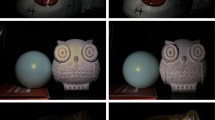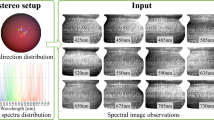Abstract
In this paper, we address the problem of the simultaneous recovery of the shape and refractive index of an object from a spectro-polarimetric image captured from a single view. Here, we focus on the diffuse polarisation process occuring at dielectric surfaces due to subsurface scattering and transmission from the object surface into the air. The diffuse polarisation of the reflection process is modelled by the Fresnel transmission theory. We present a method for estimating the azimuth angle of surface normals from the spectral variation of the phase of polarisation. Moreover, we estimate the zenith angle of surface normals and index of refraction simultaneously in a well-posed optimisation framework. We achieve well-posedness by introducing two additional constraints to the problem, including the surface integrability and the material dispersion equation. This yields an iterative solution which is computationally efficient due to the use of closed-form solutions for both the zenith angle and the refractive index in each iteration. To demonstrate the effectiveness of our approach, we show results of shape recovery and surface rendering for both real-world and synthetic imagery.


















Similar content being viewed by others
References
Atkinson, G., & Hancock, E. R. (2005). Recovery of surface height using polarization from two views. In CAIP (pp. 162–170).
Atkinson, G. A., & Hancock, E. R. (2005). Multi-view surface reconstruction using polarization. In IEEE International Conference on Computer Vision (ICCV’05) (Vol. 1, pp. 309–316). Washington: IEEE Comput. Soc.
Atkinson, G., & Hancock, E. (2006). Recovery of surface orientation from diffuse polarization. IEEE Transactions on Image Processing, 15(6), 1653–1664.
Atkinson, G., & Hancock, E. R. (2007a). Surface reconstruction using polarization and photometric stereo. In CAIP (pp. 466–473).
Atkinson, G. A., & Hancock, E. R. (2007b). Shape estimation using polarization and shading from two views. IEEE Transactions on Pattern Analysis and Machine Intelligence, 29(11), 2001–2017.
Belhumeur, P. N., Kriegman, D. J., & Yuille, A. L. (1999). The bas-relief ambiguity. International Journal of Computer Vision, 35(1), 33–44.
Born, M., & Wolf, E. (1999). Principles of optics: electromagnetic theory of propagation, interference and diffraction of light (7th ed.). Cambridge: Cambridge University Press.
Chen, H., & Wolff, L. (1998). Polarization phase based method for material classification in computer vision. International Journal of Computer Vision, 28(1), 73–83.
Coleman, T. F., & Li, Y. (1996). A reflective Newton method for minimizing a quadratic function subject to bounds on some of the variables. SIAM Journal on Optimization, 6(4), 1040–1058.
Denes, L. J., Gottlieb, M. S., & Kaminsky, B. (1998). Acousto-optic tunable filters in imaging applications. Optical Engineering, 37, 1262.
Drbohlav, O., & Šára, R. (2001). Unambiguous determination of shape from photometric stereo with unknown light sources. In International conference on computer vision (Vol. 1, pp. 581–586). Los Alamitos: IEEE Comput. Soc.
Frankot, R. T., & Chellappa, R. (1988). A method for enforcing integrability in shape from shading algorithms. IEEE Transactions on Pattern Analysis and Machine Intelligence, 10(4), 439–451.
Gonzalez, R. C., & Woods, R. E. (1992). Digital image processing (2nd ed.). Boston: Addison-Wesley/Longman.
Goudail, F., Terrier, P., Takakura, Y., Bigué, L., Galland, F., & DeVlaminck, V. (2004). Target detection with a liquid-crystal-based passive stokes polarimeter. Applied Optics, 43(2), 274–282.
Gupta, N., Dahmani, R., & Choy, S. (2002). Acousto-optic tunable filter based visible- to near-infrared spectropolarimetric imager. Optical Engineering, 41(5), 1033–1038.
Hall, J. S. (1951). Some polarization measurements in astronomy. Journal of the Optical Society of America, 41(12), 963–966.
Harris, S. E., & Wallace, R. W. (1969). Acousto-optic tunable filter. Journal of the Optical Society of America, 59(6), 744–747.
Hawryshyn, C. W. (2000). Ultraviolet polarization vision in fishes: possible mechanisms for coding e-vector. Philosophical Transactions of the Royal Society of London. Series B, Biological Sciences, 355(1401), 1187–1190.
Hecht, E. (2002). Optics (4th ed.). Reading: Addison-Wesley.
Kasarova, S. N., Sultanova, N. G., Ivanov, C. D., & Nikolov, I. D. (2007). Analysis of the dispersion of optical plastic materials. Optical Materials, 29(11), 1481–1490.
Mandel, L., & Wolf, E. (1995). Optical coherence and quantum optics. Cambridge: Cambridge University Press.
Marshall, N. J., Land, M. F., King, C. A., & Cronin, T. W. (1991). The compound eyes of mantis shrimps (Crustacea, Hoplocarida, Stomatopoda). I. Compound eye structure: the detection of polarized light. Philosophical Transactions of the Royal Society of London. Series B, Biological Sciences, 334(1269), 33–56.
Miyazaki, D., Saito, M., Sato, Y., & Ikeuchi, K. (2002). Determining surface orientations of transparent objects based on polarization degrees in visible and infrared wavelengths. Journal of the Optical Society of America. A, Online, 19(4), 687–694.
Miyazaki, D., Tan, R. T., Hara, K., & Ikeuchi, K. (2003). Polarization-based inverse rendering from a single view. In IEEE international conference on computer vision (Vol. 2, p. 982).
Miyazaki, D., Kagesawa, M., & Ikeuchi, K. (2004). Transparent surface modeling from a pair of polarization images. IEEE Transactions on Pattern Analysis and Machine Intelligence, 26(1), 73–82.
Nayar, S. K., Fang, X.-S., & Boult, T. (1997). Separation of reflection components using color and polarization. International Journal of Computer Vision, 21(3), 163–186.
Nocedal, J., & Wright, S. J. (2006). Numerical optimization (2nd ed.). New York: Springer.
Oren, M., & Nayar, S. K. (1995). Generalization of the lambertian model and implications for machine vision. International Journal of Computer Vision, 14(3), 227–251.
Rahmann, S. (1999). Inferring 3D scene structure from a single polarization image. In SPIE proceedings on polarization and color techniques in industrial inspection (Vol. 3826, pp. 22–33).
Rahmann, S. (2000). Polarization images: a geometric interpretation for shape analysis. International Conference on Pattern Recognition, 3, 538–542.
Rahmann, S., & Canterakis, N. (2001). Reconstruction of specular surfaces using polarization imaging. In IEEE conference on computer vision and pattern recognition (Vol. 1, pp. 149–155).
Sadjadi, F. A., & Chun, C. S. L. (2004). Remote sensing using passive infrared stokes parameters. Optical Engineering, 43, 2283–2291.
Saito, M., Kashiwagi, H., Sato, Y., & Ikeuchi, K. (1999). Measurement of surface orientations of transparent objects using polarization in highlight. In IEEE conference on computer vision and pattern recognition (Vol. 1, pp. 1381).
Schlick, C. (1994). An inexpensive brdf model for physically-based rendering. Computer Graphics Forum, 13(3), 233–246.
Sellmeier, W. (1871). Zur erklrung der abnormen farbenfolge im spectrum einiger substanzen. Annalen der Physik, 219(6), 272–282.
Shannon, C. E. (1949). Communication in the presence of noise. Proceedings of the Institute of Radio Engineers, 37(1), 10–21.
Stiles, W. S., & Burch, J. M. (1959). N.P.L. colour-matching investigation: final report (1958). Optica Acta 6, 1–26.
Thilak, V., Voelz, D. G., & Creusere, C. D. (2007). Polarization-based index of refraction and reflection angle estimation for remote sensing applications. Applied Optics, 46(30), 7527–7536.
Torrance, K., & Sparrow, E. (1967). Theory for off-specular reflection from roughened surfaces. Journal of the Optical Society of America, 57(9), 1105–1112.
Torrance, K. E., Sparrow, E. M., & Birkebak, R. C. (1966). Polarization, directional distribution, and off-specular peak phenomena in light reflected from roughened surfaces. Journal of the Optical Society of America, 56(7), 916–924.
Wolff, L. B. (1990). Polarization-based material classification from specular reflection. IEEE Transactions on Pattern Analysis and Machine Intelligence, 12(11), 1059–1071.
Wolff, L. B. (1994). Diffuse-reflectance model for smooth dielectric surfaces. Journal of the Optical Society of America, 11(11), 2956–2968.
Wolff, L. B. (1997). Polarization vision: a new sensory approach to image understanding. Image and Vision Computing, 15(2), 81–93.
Wolff, L. B., & Andreou, A. G. (1995). Polarization camera sensors. Image and Vision Computing, 13(6), 497–510.
Wolff, L. B., & Boult, T. E. (1989). Polarization/radiometric based material classification. In Computer vision and pattern recognition (pp. 387–395).
Wolff, L., & Boult, T. (1991). Constraining object features using a polarization reflectance model. IEEE Transactions on Pattern Analysis and Machine Intelligence, 13(7), 635–657.
Wolff, L. B., Mancini, T. A., Pouliquen, P., & Andreou, A. G. (1997). Liquid crystal polarization camera. IEEE Transactions on Robotics and Automation, 13(2), 195–203.
Zhu, Q., & Shi, J. (2006). Shape from shading: recognizing the mountains through a global view. In IEEE computer society conference on computer vision and pattern recognition (Vol. 2, pp. 1839–1846). Los Alamitos: IEEE Comput. Soc.
Author information
Authors and Affiliations
Corresponding author
Additional information
NICTA is funded by the Australian Government as represented by the Department of Broadband, Communications and the Digital Economy and the Australian Research Council through the ICT Centre of Excellence program.
Rights and permissions
About this article
Cite this article
Huynh, C.P., Robles-Kelly, A. & Hancock, E.R. Shape and Refractive Index from Single-View Spectro-Polarimetric Images. Int J Comput Vis 101, 64–94 (2013). https://doi.org/10.1007/s11263-012-0546-3
Received:
Accepted:
Published:
Issue Date:
DOI: https://doi.org/10.1007/s11263-012-0546-3




